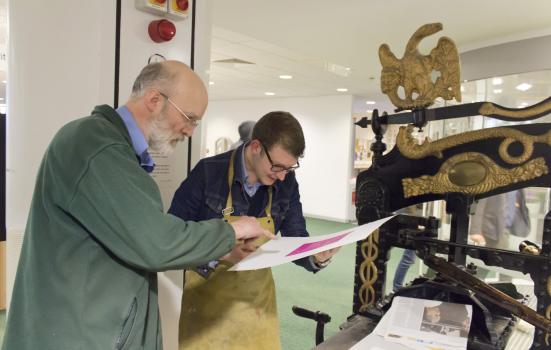The University of Bath – a university that offers no arts courses – recently launched a new arts venue, but its artists in residence programme has been reaching out to staff, students and the local population for years, says John Struthers.

The Institute of Contemporary Interdisciplinary Arts (ICIA) at the University of Bath was officially launched in May to create a space on campus where audiences from across the region can come together with artists, scholars and students to explore contemporary arts and ideas. The university has invested £11m in the new arts venue called The Edge. It has three white cube galleries, a theatre, music practice rooms and performance studios, and is shared with the School of Management.
Vice-Chancellor, Professor Dame Glynis Breakwell, says of the new venue: “Bringing the creative arts and the study of management together under one roof is a new departure for Bath. Our aim is that this will foster a culture of creativity and innovation, add greater depth to our management programmes and promote leadership development and innovative business practice in the arts.”
It’s becoming increasingly important that arts venues within universities assert the unique value of their cultural offer and overcome challenges such as institutional anonymity
The challenges to promote art programmes within this context are many, such as successfully cultivating an ever-changing student audience and convincing academic colleagues to ‘buy in’ and champion our value.
Presently (and largely thanks to university funding) we operate from a position of relative security compared to other arts organisations. However, with all arts organisations reviewing their funding and renewing efforts to achieve long-term sustainability, it’s becoming increasingly important that arts venues within universities assert the value of their cultural offer and overcome challenges such as institutional anonymity.
A strand of our work that brings benefits all-round is our artists-in-residence programme. Artists are supported in the development of their practice and are given access to the campus and academic departments. Through our offering of time, support and freedom, artists undertake a period of research and development, experimenting with new ideas or projects, engaging with audiences and taking risks. It is sometimes difficult for artists to have the resources for open-ended research, so this approach enables them to develo p new ideas without the constraints of a definitive outcome. This opens up a process that is rarely visible and we therefore encourage alternative ways for audiences to engage.
Our most recent artist-in-residence, visual artist Barry Sykes, comments: “I had a completely open brief and realised early on that I wanted the campus to be the potential subject matter. The knowledge, research and expertise here is immense and unfathomable. I didn’t have a base so I knocked on doors and wandered round the campus. As a sculptor I was curious about the potential of all those rooms that are structurally very similar, but entirely different because of what’s housed within them – there’s the library, archives, wind tunnel, concrete labs, metrology research, testing rooms, Dojo, an Oympic-sized swimming pool, the plant room, greenhouses and all sorts of labs and lecture rooms. It felt so potent.”
Barry’s 18-month residency saw many projects to fruition, including a project with sociology students around sculpting answers to questions about how students feel, and a final exhibition including a ‘blind sculpture’. Barry asked a lab support technician in engineering and design to recreate a sculpture he saw over ten years ago, writing a brief from memory and emailing it to him. As well as giving the university new insights into the departments and campus locations that Barry explored, his work was seen by audiences he might not otherwise have reached among the student and staff population, alongside local contemporary arts audiences. And Barry’s work brings members of the local community on to the campus who may not otherwise engage with their local university, which is a big presence in the small town of Bath.
Music artist-in-residence, violinist and composer Alexander Balanescu created original works following a time collaborating with the Department of Politics, Languages and International studies. The resulting composition was inspired by the patterns of melodies and language. His residency explored the idea that we all operate in a multilingual environment, even if we do not speak or understand multiple languages. Throughout the project, students, staff and audiences engaged with each other in different ways, crossing the boundaries of language and music and gaining new insights into their respective disciplines and perception of spoken and musical language.
Going forward, we are working to expand the artist residency programme, using other more lucrative strands to support it. This artist residency link is essential to the continued relationship between us and the university, providing a two-way street for both organisations, plus unparalleled opportunities for artists to develop their practice within an academic and research environment.
John Struthers is Director of ICIA at the University of Bath.
www.icia.org.uk





Comments
PaulaD replied on Permalink
Sounds good on paper but...
Katy Thatcher replied on Permalink
ICIA Bath
Sylvia Rimat replied on Permalink
Recent developments at ICIA
Barry Sykes replied on Permalink
My thoughts on the above...
LOW PROFILE replied on Permalink
recent moves fail to demonstrate long-term commitment
LOW PROFILE replied on Permalink
further reading - a long conversation